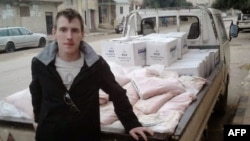The parents of Abdul-Rahman (formerly Peter) Kassig, the American aid worker beheaded by Islamic State (IS) militants in Syria, have expressed their pride in their son, who they say lived his life "according to his humanitarian calling."
Ed and Paula Kassig released a statement via their Facebook page on November 16, after news of their son's brutal death was confirmed.
"We are heartbroken to learn that our son, Abdul-Rahman Peter Kassig, has lost his life as a result of his love for the Syrian people and his desire to ease their suffering. Our heart also goes out to the families of the Syrians who lost their lives, along with our son," the Kassig family statement read.
Kassig was a certified EMT (emergency medical technician) who served in the U.S. military in Iraq as an Army Ranger from April until July 2007.
In Syria, Kassig worked as an aid worker and medic through an aid organization he had founded in Lebanon, Special Emergency Response and Assistance (SERA).
He was abducted by IS militants on October 1, 2013, while traveling in an ambulance to deliver medical supplies to civilians in Deir Ezzor Province. While in captivity, Kassig converted to Islam and changed his name from Peter to Abdul-Rahman.
His parents had initially requested a media blackout, but later made a number of public appeals to Islamic State for their son's release.
In their statement, Kassig's parents said that their son had "found his home" among the Syrian people. "Fed by a strong desire to use his life to save the lives of others, Abdul-Rahman was drawn to the camps that are filled with displaced families and to understaffed hospitals inside Syria," they said.
The Kassigs also shared part of a letter written by their son in March 2012, when he told them he was taking a leave of absence from Butler University to go to Syria, where he hoped to "make a difference." "Here, in this land, I have found my calling," Kassig wrote.
After the news of Kassig's killing broke on November 16, photos of the American Muslim convert carrying out aid work in Syria were shared on social media. BBC journalist Julia Macfarlane noted that Kassig had "treated, fed, and helped Syrians and Palestinians."
Others shared quotes from letters Kassig had written to his friends while in Syria:
Butler University, where Kassig had studied political science before going to Lebanon, described its former student as a "peaceful Bulldog" in a tribute tweet:
In previous videos showing the executions of Western hostages, the victims were filmed dressed in orange clothing and kneeling in front of their executioner, a British militant. The November 16 video referencing Kassig, however, just shows the British militant with a severed head at his feet. The militant claims the head is Kassig's.
McClatchy reporter Mitchell Prothero, who shared an apartment in Beirut with Kassig, suggested the American may have refused to cooperate with his captors. "Clearly something went wrong. Pete was a high-value prize for them. That's why he went last -- he was an American soldier, he'd been a humanitarian worker, and they were saving him for the last.... My belief is that he knew it was up and did something to screw up their video," he said.
The aid worker's friends suggested that Kassig may have defied his captors before his beheading.
While it is impossible to know for sure whether Kassig was able to defy his captors, the American aid worker's final letter to his parents showed that he was able to cope under the extreme stress of captivity by finding comfort in his fellow prisoners and in the knowledge of his family's love.
"I have friends, we laugh, we play chess, we play trivia to stay sharp, and we share stories and dreams of home and loved ones.... I am obviously pretty scared to die but the hardest part is not knowing, wondering, hoping, and wondering if I should even hope at all. I am very sad that all this has happened and for what all of you back home are going through. If I do die, I figure that at least you and I can seek refuge and comfort in knowing that I went out as a result of trying to alleviate suffering and helping those in need," Kassig wrote.
Kassig is the fifth Western hostage to be killed by IS. The group has beheaded two British aid workers, David Haines and Alan Henning, and two American journalists, Steven Sotloff and James Foley.
-- Joanna Paraszczuk





